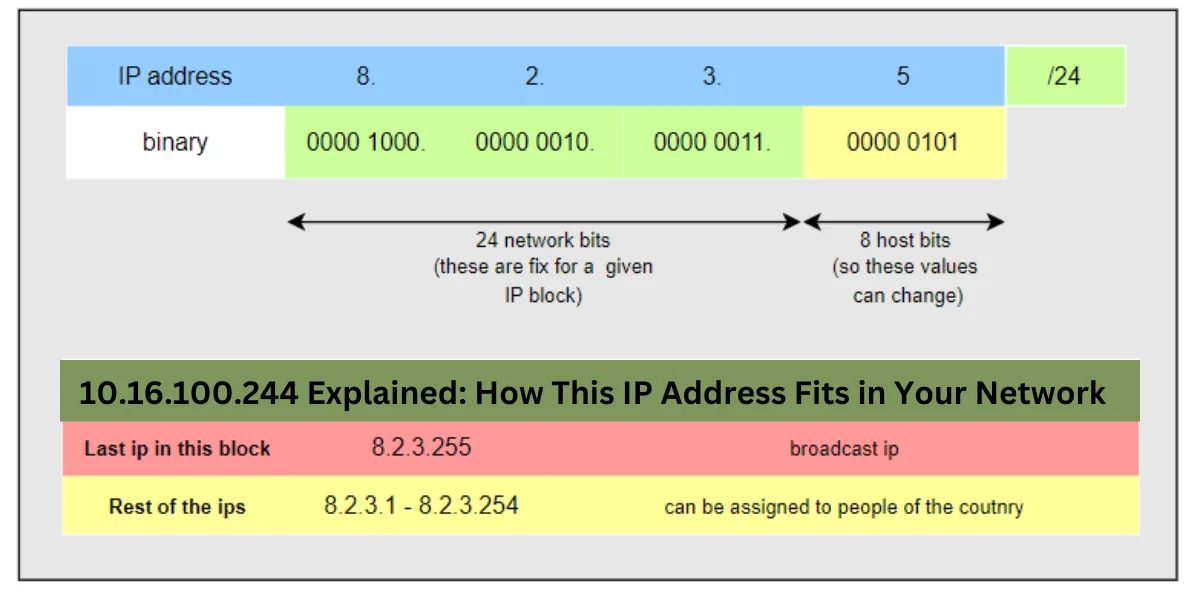Understanding how specific IP addresses like 10.16.100.244 function within a network is crucial for network administrators, IT professionals, and anyone involved in managing a digital environment. In this comprehensive guide, we will delve into the basics of IP addressing, explore what makes 10.16 100.244 unique, and outline the benefits of using this IP address within your network. By the end of this article, you will have a clear understanding of how 10.16 100.244 fits into your network infrastructure and its optimal utilization.
Also raed: 139.59.223.45 Explained: A Complete Guide | 34.217.198.225: A Guide to Configuring This Public IP Address
What is an IP Address? Understanding the Basics
An Internet Protocol (IP) address is a unique string of numbers separated by periods that identifies each computer using the Internet Protocol to communicate over a network. IP addresses serve as the fundamental component of networking, enabling data to be routed from one device to another. There are two main types of IP addresses:
- IPv4 Addresses: The most common type, consisting of four sets of numbers (0-255) separated by periods (e.g., 192.168.0.1).
- IPv6 Addresses: Designed to replace IPv4 due to the shortage of available addresses, consisting of eight groups of four hexadecimal digits separated by colons (e.g., 2001:0db8:85a3:0000:0000:8a2e:0370:7334).
The Role of Private IP Addresses in Networking
Private IP addresses are used within a local network and are not routed on the public internet. They are part of the IP address ranges reserved for private use as defined by the Internet Assigned Numbers Authority (IANA). These ranges are:
- 10.0.0.0 to 10.255.255.255
- 172.16.0.0 to 172.31.255.255
- 192.168.0.0 to 192.168.255.255
Private IP addresses are ideal for devices within a home or corporate network that do not need to communicate directly with external networks.
Understanding 10.16.100.244: A Private IP Address
The IP address 10.16.100 244 falls within the private IP address range of 10.0.0.0 to 10.255.255.255, which is designated for internal network use. This range is often used by large organizations for internal communication and ensures that IP conflicts with public addresses do not occur. Let’s explore the characteristics of the 10.16 100.244 IP address:
- Private Use: 10.16 100.244 is a non-routable address on the public internet, meaning it can only be used within a private network.
- Class A IP Address: Belonging to Class A, this IP address has a default subnet mask of 255.0.0.0, allowing for a large number of possible subnets and hosts.
- Flexibility: Class A addresses are versatile, supporting extensive network growth by allowing more hosts on each subnet.
How 10.16.100.244 Fits Into Your Network
Understanding how 10.16.100 244 fits into your network starts with understanding subnetting and the role of internal IP addresses. Here are some critical aspects to consider:
1. Network Segmentation
10.16.100.244 can be part of a subnet that segments your network to improve performance and security. Network segmentation divides a large network into smaller, manageable sections, reducing congestion and isolating network traffic.
Benefits of Network Segmentation with 10.16.100.244:
- Improved Security: Limits the exposure of devices to threats within the same network.
- Better Performance: Reduces the amount of broadcast traffic, enhancing network speed.
- Simplified Troubleshooting: Smaller segments make pinpointing issues easier.
2. Device Addressing
Incorporating 10.16 100.244 as a static or dynamic IP address within your network allows precise control over device addressing. This control is crucial in environments where devices need consistent and reliable connections, such as servers, printers, and other critical infrastructure components.
Benefits of Device Addressing Using 10.16 100.244:
- Stable Connections: Ensures devices always connect to the correct network resources.
- Ease of Management: Facilitates easier network management and monitoring.
- Conflict Avoidance: Helps avoid IP conflicts that can disrupt network operations.
3. Network Monitoring and Management
Using 10.16 100.244 in conjunction with network management tools enables efficient monitoring of network traffic. This IP address can be assigned to management interfaces or devices used for network monitoring, ensuring a dedicated path for critical network data.
Benefits of Network Monitoring with 10.16.100.244:
- Enhanced Visibility: Provides clear insight into network performance and potential issues.
- Quick Response: Allows rapid identification and response to anomalies or security breaches.
- Resource Optimization: Helps optimize the use of network resources, reducing downtime.
Also read: Top 10 Low Taper Fade Styles for Men in 2024 | Thejavasea.me Leaks Aio-Tlp
Setting Up 10.16.100.244 in Your Network
To effectively use 10.16.100 244, it is essential to configure it correctly within your network’s architecture. Here are the steps to set up this IP address:
Step 1: Determine the Role of 10.16.100.244
Decide whether 10.16 100.244 will be used as a static address for a specific device or as part of a dynamic pool managed by a DHCP server. Common roles include:
- Assigning it to a network printer, server, or other critical devices.
- Using it as a gateway address for specific subnets within the network.
Step 2: Subnet Configuration
Configure the subnet mask according to your network’s design. For example, if 10.16 100.244 is part of a Class A network, using a subnet mask of 255.255.255.0 would allow for 254 usable addresses within the subnet, providing ample room for growth.
Step 3: Apply Access Controls
Apply access control lists (ACLs) and firewall rules to manage traffic to and from 10.16 100.244. These controls help maintain security by limiting access to authorized users and devices.
Step 4: Monitor and Maintain
Once configured, continuously monitor 10.16.100 244 to ensure it is functioning correctly within your network. Utilize network management tools to track performance, detect anomalies, and maintain optimal operation.
Security Considerations for 10.16.100.244
Security is a paramount concern when configuring any IP address within a network, including 10.16.100 244. Since this address is used within a private network, internal security measures become even more critical. Here’s how you can secure 10.16.100 244:
1. Implement Strong Access Controls
Use strong access controls to restrict access to devices using 10.16.100 244. Only authorized personnel should be able to configure or interact with devices assigned to this IP address.
Benefits of Access Control:
- Reduced Risk of Unauthorized Access: Ensures that sensitive devices and data remain protected.
- Enhanced Compliance: Helps meet regulatory requirements for data security.
2. Use Network Security Tools
Employ firewalls, intrusion detection systems (IDS), and intrusion prevention systems (IPS) to protect your network. These tools can help monitor traffic to and from 10.16.100 244, preventing unauthorized access and potential threats.
Benefits of Network Security Tools:
- Proactive Threat Detection: Identifies potential threats before they can impact the network.
- Data Integrity: Ensures that data transmitted to and from 10 16.100.244 remains secure.
3. Regular Audits and Updates
Conduct regular audits of your network, focusing on IP addresses like 10.16.100 244, to ensure they are functioning as intended. Regular updates to network security protocols and firmware also help protect against the latest threats.
Benefits of Regular Audits:
- Improved Security Posture: Keeps your network up-to-date with the latest security measures.
- Early Issue Identification: Allows for the early detection of configuration errors or security vulnerabilities.
Troubleshooting Common Issues with 10.16.100 244
Properly managing 10.16 100 244 requires awareness of common issues that may arise and knowing how to troubleshoot them effectively. Here are some common problems and their solutions:
1. IP Address Conflicts
If multiple devices attempt to use 10.16.100 244, an IP conflict occurs, leading to connectivity issues.
Solution: Use a centralized DHCP server to manage IP assignments and ensure that static IP addresses are documented and reserved.
2. Connectivity Issues
Devices assigned to 10.16.100 244 may face connectivity problems due to misconfigured subnet masks or access controls.
Solution: Double-check network configurations, including subnet masks and access control lists, to ensure correct setup.
3. Unauthorized Access Attempts
Monitoring tools may detect unauthorized attempts to access 10.16.100 244, indicating potential security breaches.
Solution: Review security logs, strengthen access controls, and ensure that network security tools are functioning correctly.
The Benefits of Using 10.16.100.244 in Your Network

Using 10.16.100.244 within your private network provides several benefits that enhance overall network performance, security, and manageability.
1. Improved Network Organization
Assigning specific IP addresses like 10.16 100.244 to essential devices helps maintain an organized and easily manageable network.
2. Enhanced Security
Being a private IP address, 10.16.100 244 inherently enhances security by isolating internal network traffic from external threats.
3. Scalability
10.16.100 244’s placement within a Class A address range allows for significant scalability, accommodating network growth without compromising performance.
Also raed: Grace Charis Age | kelly bates asks supporters not to take out their anger on nbc 10
Conclusion: Leveraging 10.16.100.244 for Optimal Network Performance
Incorporating 10.16.100 244 into your network strategy offers many advantages, from improved organization and enhanced security to better performance monitoring. By understanding how this IP address functions within the private address space, network administrators can make informed decisions that optimize their network environment. Proper configuration, security measures, and ongoing maintenance of 10.16.100.244 will ensure it remains a valuable asset in your network infrastructure.
FAQ:
1. Can 10.16.100.244 be used for network segmentation?
Yes, 10.16.100 244 can be used within network segmentation strategies to create isolated subnets. This setup improves security by limiting device communication to within defined segments, thus protecting sensitive data.
2. Is 10.16.100.244 suitable for IoT devices?
Yes, 10.16.100 244 is suitable for IoT devices within a private network. Assigning static IPs like 10.16.100.244 to critical IoT devices ensures they remain consistently reachable, which is crucial for device communication and management.
3. Can 10.16.100.244 be part of a VPN configuration?
Yes, 10.16 100.244 can be used within a VPN configuration to facilitate secure internal communication between devices over a private network. VPNs can provide encrypted pathways for devices using this IP to connect securely, even across different geographical locations.
4. Can 10.16.100 244 be accessed from outside my network?
No, 10.16.100 244 is a private IP address and is not accessible directly from the internet. It can only be accessed within the internal network it belongs to. External access would require port forwarding or VPN configurations, which involve additional security considerations.
